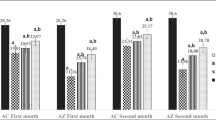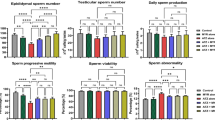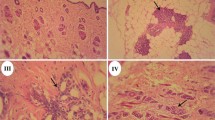Abstract
The present study has investigated the ability of amitraz, a widely used formamidine pesticide, to modulate serum concentrations and liver microsomal metabolism of 17β-estradiol (E2) and testosterone in rats. Amitraz was administered intraperitoneally to male rats for 4 days and to intact female rats or ovariectomized (OVX) and 0.5 mg/kg E2-supplemented female rats for 7 days. E2 and metabolites were analyzed by gas chromatography-electron capture detection and testosterone and metabolites were analyzed by high-pressure liquid chromatography. In OVX and E2-supplemented females, 50 mg/kg amitraz caused an 85% decrease of serum E2 concentration and a marked increase of 2-OH-E2 concentration. Amitraz at 25 and 50 mg/kg produced 9.0-fold or greater increases of serum testosterone and 2β-OH-testosterone levels in males. Amitraz at 25 mg/kg resulted in no or minimal increases of liver microsomal formation of E2 or testosterone metabolites. Amitraz at 50 mg/kg produced 1.4- to 3.6-fold increases of 2-OH-E2; estrone; 2β-, 6β-, and 16α-OH-testosterone; and androstenedione formation in males and intact females. Amitraz at 50 mg/kg preferentially increased intact female 16β-OH-testosterone production by 8.6-fold. In OVX females, E2 supplement alone or cotreatment with E2 and 50 mg/kg amitraz produced 1.3- to several-fold increases of 2- and 4-OH-E2 formation and 2β- and 16α-OH-testosterone production. The cotreatment increased 6β- and 16β-OH-testosterone formation by 1.8- and 1.6-fold, respectively. The present findings show that amitraz induces hepatic E2 and testosterone metabolism in male and female rats, decreases serum E2 concentration in OVX and E2-supplemented females, but increases serum testosterone in males.




Similar content being viewed by others
References
al-Qarawi AA, al-Damegh MS, Adam SE (1999) Effects of amitraz given by different routes on rats. Vet Hum Toxicol 41:355–357
Al-Thani RK, Al-Thani AS, Elbetieha A, Darmani H (2003) Assessment of reproductive and fertility effects of amitrz pesticide in male mice. Toxicol Lett 138:253–260
Anway MD, Cupp AS, Uzumcu M, Skinner MK (2005) Epigenetic transgenerational actions of endocrine disruptor and male fertility. Science 308:1466–1469
Arlotto MP, Trant JM, Estabrook RW (1991) Measurement of steroid hydroxylation reactions by high-performance liquid chromatography as indicator of P450 identity and function. Methods Enzymol 206:454–462
Baltes MRH, Dubois JG, Hanocq M (1998) Ethyl acetate extraction procedure and isocratic high-performance liquid chromatographic assay for testosterone metabolites in cell microsomes. J Chromatogr B Biomed Sci Appl 706:201–207
Costa LG, Olibet G, Murphy SD (1988) Alpha2-adrenoceptors as a target of formamidine pesticides: in vitro and in vivo studies in mice. Toxicol Appl Pharmacol 93:319–328
Dai D, Cao Y, Fall G, Levi PE, Hodgson E, Rose R (2001) Modulation of mouse P450 isoforms CYP1A2, CYP2B10, CYP2E1, and CYP3A by the environmental chemicals mirex, vinclozolin, and flutamide. Pestic Biochem Physiol 70:127–141
Goldman JM, Cooper RL, Rehnberg GL, Edwards TL, McElroy WK, Hein J (1990) Chlordimeform-induced alterations in endocrine regulation within the male rat reproductive system. Toxicol Appl Pharmacol 104:25–35
Goldman JM, Cooper RL, Rehnberg GL, Edwards TL, McElroy WK, Hein J (1991) Suppression of the luteinizing hormone surge by chlordimeform in ovariectomized, steroid-primed female rats. Pharmacol Toxicol 68:131–136
Goldman JM, Laws SC, Balchak SK, Cooper RL, Kavlock RJ (2000) Endocrine-disrupting chemicals: prepubertal exposure and effects on sexual maturation and thyoid activity in the female rat. A focus on the EDSTAC recommendations. Crit Rev Toxicol 30:135–196
Guillette LJ (2006) Endocrine disrupting contaminants-beyond the dogma. Environ Health Perspect 114:9–12
Kavlock RJ, Ankley GT (1996) A perspective on the risk assessment process for endocrine-disruptive effects on wildlife and human health. Risk Anal 16:731–739
Kim JC, Shin JY, Yang YS, Shin DH, Moon CJ, Kim SH, Park SC, Kim YB, Kim HC, Chung MK (2007) Evaluation of developmental toxicity of amitraz in Sprague-Dawley rats. Arch Environ Contam Toxicol 52:137–144
Li HC, Dehal SS, Kupfer D (1995) Induction of the hepatic CYP2B and CYP3A enzymes by the proestrogenic pesticide methoxychlor and by DDT in the rat. Effects on methoxychlor metabolism. J Biochem Toxicol 10:51–61
Lowry OH, Rosebrough NJ, Farr AL, Randall RJ (1951) Protein determinations with Folin phenol reagent. J Biol Chem 193:265–275
Magnusson MO, Sandström R (2004) Quantitative analysis of eight testosterone metabolites using column switching and liquid chromatography/tandem mass spectrometry. Rapid Commun Mass Spectrom 18:1089–1094
Moser VC (1991) Investigations of amitraz neurotoxicity in rats. IV. Assessment of toxicity syndrome using a functional observation battery. Fundam Appl Toxicol 17:7–16
Nash T (1953) The colorimetric estimation of formaldehyde by means of the Hantzsch reaction. Biochem J 55:416–421
Omura T, Sato R (1964) The carbon monoxide-binding pigment of liver microsomes. I. Evidence for its hemoprotein nature. J Biol Chem 239:2370–2378
Oropeza-Hernandez LF, Lopez-Romero R, Albores A (2003) Hepatic CYP1A, 2B, 2C, 2E and 3A regulation by methoxychlor in male and female rats. Toxicol Lett 144:93–103
Palermo-Neto J, Florio JC, Sakate M (1994) Developmental and behavioral effects of prenatal amitraz exposure in rats. Neurotoxicol Teratol 16:65–70
Pinnella KD, Cranmer BK, Tessari JD, Cosma GN, Veeramachaneni DN (2001) Gas chromatographic determination of catecholestrogens following isolation by solid-phase extraction. J Chromatogr B Biomed Sci Appl 758:145–152
Poirier D, Bydal P, Tremblay MR, Sam KM, Luu-The V (2001) Inhibitors of type II 17beta-hydroxysteroid dehydrogenase. Mol Cell Endocrinol 171:119–128
Ryan DE, Levin W (1990) Purification and characterization of hepatic microsomal cytochrome P-450. Pharmacol Ther 45:153–229
Safe S, Wormke M (2003) Inhibitory aryl hydrocarbon receptor-estrogen receptor cross-talk and mechanism of action. Chem Res Toxicol 16:807–816
Satoh T, Fujita KL, Munakata H, Itoh S, Nakamura K, Kamataki T, Yoshizawa I (2000) Studies on the interactions between drugs and estrogen: analytical method for prediction system of Gynecomastia induced by drugs on the inhibitory metabolism of estradiol using Escherichia coli coexpressing human CYP3A4 with human NADPH-cytochrome P450 reductase. Anal Biochem 286:179–186
Ueng TH, Hung CC, Wang HW, Chan PK (2004) Effects of amitraz on cytochrome P450-dependent monooxygenases and estrogenic activity in MCF-7 human breast cancer cells and immature female rats. Food Chem Toxicol 42:1785–1794
Williams TM, Borghoff SJ (2000) Induction of testosterone biotransformation enzymes following oral administration of methyl tert-butyl ether to male Sprague-Dawley rats. Toxicol Sci 57:147–155
Wood AW, Ryan DR, Thomas PE, Levin W (1983) Regio- and steroselective metabolism of two C19 steroids by five highly purified and reconstituted rat hepatic cytochrome P-450 isozymes. J Biol Chem 258:8839–8847
Yager JD, Liehr JG (1996) Molecular mechanisms of estrogen carcinogenesis. Ann Rev Pharmacol Toxicol 36:203–232
Zhu BT, Conney AH (1998) Functional role of estrogen metabolism in target cells: review and perspectives. Carcinogenesis 19:1–27
Acknowledgments
This work was supported in part by research grants 96AS-14.2.2-BQ-B3 from Council of Agriculture and NSC95-2314-B-002-256-My3 from National Science Council, R.O.C.
Author information
Authors and Affiliations
Corresponding author
Rights and permissions
About this article
Cite this article
Chou, CP., Lu, SY. & Ueng, TH. Modulation of serum concentrations and hepatic metabolism of 17β-estradiol and testosterone by amitraz in rats. Arch Toxicol 82, 729–737 (2008). https://doi.org/10.1007/s00204-008-0288-8
Received:
Accepted:
Published:
Issue Date:
DOI: https://doi.org/10.1007/s00204-008-0288-8




